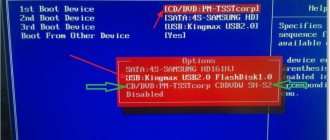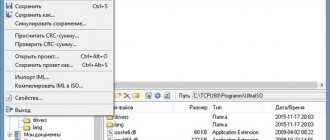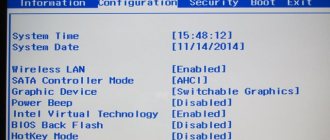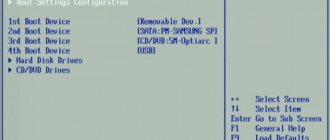BIOS firmware
If you do not want to run the bat file from the archive (perhaps you are smarter than the developers, or they forgot to put it there), then: (The following applies to the Phoenix BIOS, although with the InsydeH2O BIOS the scheme of actions is approximately the same)
1) you can flash the BIOS from DOS
Just in case, prepare a Crisis Disk, it will be discussed below.
Create a bootable USB flash drive, according to the article Creating a bootable USB flash drive with DOS
We write a flasher and a BIOS file to it
We launch the flasher, examples: If the BIOS is from Phoenix: phlash16 /x /c /mfg /mode=3 my_bios.wph If the BIOS is from InsydeH2O: flashit my_bios.fd /fe /b
These are almost standard options, more about them below. If you need something specific, add additional firmware options to your liking. But, generally speaking, it is better to look into the bat file, which should be in the archive in the DOS firmware, and copy the options for the flasher from there.
Command line options for Phoenix Flash Utility for DOS - Version 1.7.0.0 Phoenix16.exe
Command line options for InsydeH2O Flash Utility for DOS - Version 1.3i FLASHIT.exe
After flashing the firmware, the laptop reboots and voila - you have new firmware. This is if everything went smoothly. By the way, before flashing the new one, you can make a backup of the old BIOS, the key is /BU.
2) you can flash the BIOS from Windows
Close all running programs, disable the antivirus, disconnect from the network and the Internet. In the same folder with the flasher there should be a BIOS file for YOUR
laptop models Run Winflash or Winflash64 as administrator First, make a BIOS backup without flashing If you need something specific, click the Advanced button Flash the BIOS
How to update BIOS on a Lenovo laptop
Once again, a standard instruction, since Lenovo also provides its customers with a standard installer for installing the updated BIOS version:
- Go to support.lenovo.com and find your device in the search bar.
- After this, we go to the driver and software download section, where we set the search filter to the required OS values and the desired category of files to download.
- Then download the files found for updating.
- We carry out the installation according to the instructions of the automatic installer, and then reboot the device.
Nuances of installing updates
Before updating the BIOS, you need to know a number of nuances:
- You should always choose the latest version of the update, because problems that arise in the operation of certain devices can be eliminated by installing a version an order of magnitude higher and no more (determining the current version will be discussed below);
- if the update is necessary to restore the operation of the laptop (there is no access to the OS desktop), then you can use the standard installer only after access has been restored via a bootable USB flash drive or disk (the traditional option is Windows Live CD or analogs).
Checking the BIOS version
The check can be performed in two main ways:
- You just need to go to the graphical interface when the device starts up and find the necessary information in the main menu.
- In Windows, just use the key combination “Win” + “R” and enter the phrase msinfo32.
- In the window that opens, select the “System Information” sub-item, and then study the desired item.
After receiving this value, you can begin updating using the method described for devices from a specific manufacturer.
Updating the BIOS is not a complicated process, but it requires some care from the user. Only if you follow the basic instructions can you achieve the desired result: eliminate the main problems that have arisen due to the obsolescence of its version. It is best to entrust this procedure to a specialist who can conduct diagnostics and understand whether the BIOS is really the cause of the inoperability of certain OS components.
How to update BIOS on an Acer laptop
To update the BIOS on an Acer Aspire laptop, you must follow the same steps as the previous instructions:
- Link to the official device search page from the manufacturer Acer Aspire: https://www.acer.com/ac/ru/RU/content/support.
- Having selected the desired device and OS version, go to the boot menu:
- By going to the download page, you need to select a newer BIOS version and download the update files.
- Installing updates on Acer Spire is carried out by analogy with devices from HP. You must follow the instructions of the automatic installer, and then reboot the device.
Conclusion
From the examples discussed, it is clear that updating the BIOS is not a difficult task at all. But when updating, you need to be extremely careful and not allow the computer to turn off during this process.
I would also like to remind our readers once again that under no circumstances use BIOS files for firmware from unofficial sources, as this can lead to breakdowns and you will have to restore your computer at a service center.
We hope that, guided by our examples, readers will be able to update the BIOS, thereby ensuring stable operation of their PC.
How to update BIOS on an Asus laptop
Let's look at the update procedure for the Asus B9440UA model, moving from BIOS version 201 to 301:
- The latest BIOS update packages can be downloaded from the official website of the ASUS manufacturer (https://www.asus.com/ru/support/).
- In the search bar of the site, you must enter the above laptop model, or any other (you can look at the laptop case if the owner does not know other ways to determine this value).
- Then you should select the “Drivers and Utilities” item, specifying the parameters of the installed OS and going to the “BIOS” item to download the latest update package.
- The downloaded archive must be unpacked and placed on a USB drive.
- Then, as described above, you need to enter the BIOS by selecting the “Advanced Mode” advanced configuration section.
- In this section, go to “ASUS EZ Flash 3 Utility”.
- At this point you can go to one of the connected drives (internal or external).
- Then we should select the file we need, confirming the fact that the update will be carried out through it.
- The entire procedure takes about 2 minutes, after which the system will reboot. You will be able to start working on the updated BIOS platform.
How to update BIOS on an HP laptop
The manufacturer Hewlett-Packard took care of its customers - the update is implemented into the system without reboots or complex manipulations. Just follow the instructions:
- First, you should go to the official driver search page: https://support.hp.com/ua-ru/drivers.
- Then you need to go to the page for a specific model by entering the code (on the back cover of the case) or the exact name in the search bar.
- On the next page we indicate the version of the OS installed on the selected device.
- In the proposed list of downloadable materials, you must select BIOS and obtain the latest update package.
- The update package in this case looks like a regular installable file that can be launched, but with a number of conditions: the laptop must be in a charging state (working through the battery can be interrupted abnormally), any programs, anti-virus software, firewalls, etc. should be disabled.
- Next, run the file, follow the instructions and reboot the laptop to continue working with the new BIOS.
Popular files for ACER Extensa 5220
For:
Windows Vista 64-bit
Released:
2008.11.06
Release:
10.46.0.0
Size:
4.72 Mb (ZIP)
For:
Windows Vista 64-bit
Released:
2008.11.06
Release:
11.5.0.34
Size:
39.38 Mb (ZIP)
For:
Windows Vista
Released:
2008.11.05
Release:
10.46.0.0
Size:
4.66 Mb (ZIP)
For:
Windows Vista
Released:
2008.11.05
Release:
7.2.0.215
Size:
2.87 Mb (ZIP)
For:
Windows Vista 64-bit
Released:
2008.11.06
Release:
2.0.6
Size:
14.31 Mb (ZIP)
For:
Windows Vista, Windows Vista 64-bit
Released:
2008.12.04
Release:
2.5.4015
Size:
15.26 Mb (ZIP)
For:
Windows Vista, Windows Vista 64-bit
Released:
2008.12.04
Release:
2.5.4302











